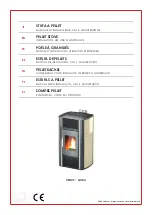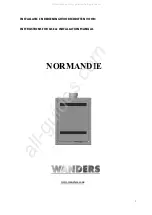
32
Vermont Castings • Intrepid II Installation & Operating Manual_R48 • 11/17
3-90-2000966
1. Remove the existing gasket by grasping an end and pulling
firmly.
2. Use a wire brush or a screwdriver to clean the channel of
any remaining cement or bits of gasket. Remove stubborn
deposits of cement with a cold chisel if necessary.
3. Determine the correct length of the appropriate-sized
gasket by laying it out in the channel. Allow an extra 1-2"
(25-50mm) and mark the spot to be cut.
4. Remove the gasket from the channel, place it on a wood
cutting surface, and cut it at the marked spot with a utility
knife. Twist the ends slightly to keep the gasket from
unraveling.
5. Lay an unbroken 1/8" (3mm) bead of gasket cement in
the newly-cleaned channel. Starting at one end, press the
gasket into the channel. Ensure a good joint where the
gasket meets before trimming any excess. Do not overlap
the gasket ends or leave ends with ragged edges.
6. Press the gasketed part firmly against its normal mating
surface to seat the gasket evenly in its channel.
7. For doors, replace the doors and close them on a piece
of waxed paper to keep the cement from migrating onto
the stove front, or tap other parts with the rubber mallet
(or hammer/block of wood).
8. Clean excess cement from around the channel. Let the
cement that holds the new gasket dry thoroughly.
Adjust the Door if Necessary:
The door latch or damper mechanism may need adjustment
after you have regasketed them. Initially, it may require
loosening to accommodate the new gasket; after a few
weeks, it may need tightening to compensate for compression
of the new gasket.
Permanent Gaskets:
Other gaskets seal between non-moving parts, but these are
not subject to the same wear and deterioration as gaskets on
moving parts. It is unlikely that you will ever need to replace
these gaskets unless the involved parts are disassembled
and then put back together. If this is the case, the job should
be done only by a qualified service technician. The diameter
of the gasket that seals these non-moving parts is 5/16",
and the areas sealed are the flue collar to the stove back;
and the lower fireback to the sides. The glass panels use a
special die-cut flat gasket; refer to "Glass Replacement" for
information on these.
Replace Refractory Package:
Refer to Figure 46.
1. Remove andirons.
2. Reach inside the stove with pair of pliers and turn the
two clamps that hold the fireback 90°. Turn the let clamp
clockwise and the right clamp counterclockwise. The
bolts that hold these clamps are tapped into the back
as well as capped by chrome acorn nuts in the back.
3. Grasp the upper fireback by its vertical ribs and remove
it, together with the attached throat hood. Pull the left
side out first.
4. Carefully remove the refractory access panel in front of
the catalytic block.
5. Gently slide the catalytic block out of the refractory
chamber.
6. Remove the damper housing. It is held in place by two
weld screws and two chrome acorn nuts in the back
of the stove. Loosen the chrome acorn nuts and rotate
the tabs to release the damper housing. You may find it
necessary to remove or loosen the thermostat cover to
access the one of acorn nuts installed behind the cover.
7. Remove the rear airtube in the back of the stove which
is held in place with two phillips screws.
8. Take out the secondary probe by removing the upper
phillips screw and sliding the probe out of the hole.
9. Lift the damaged refractory chamber up and out of the
firebox.
10. Reverse the procedure for installing the new refractory
chamber.
Replace the Stove Gaskets as Needed
The Intrepid uses fiberglass rope gaskets to make a tight seal
between some parts. With use, particularly on those parts
that move, gaskets can become brittle and compressed,
and can begin to lose their effectiveness. These will need
periodic replacement.
The sizes of replaceable gasket are listed below, along with
their applications.
There is a flat, die-cut gasket between each glass panel and
its door. "Glass Replacement" for information on replacing
the glass panel or its gasket.
If you need to change a gasket, first obtain an appropriate
replacement from your Vermont Castings, Dealer.
Wait until the fire is out and the stove has cooled. Be sure to
follow the standard safety procedure for working with dusty
materials: Wear safety goggles and a dust mask.
The procedure for replacing the gaskets is the same,
regardless of the gasket location.
Gasket Diameter
And the Parts it Seals
5/16" Wire Gasket
The griddle to the stove top
5/16"
The damper to the upper fire back;
the front doors to the stove front;
and the door halves to each other.











































